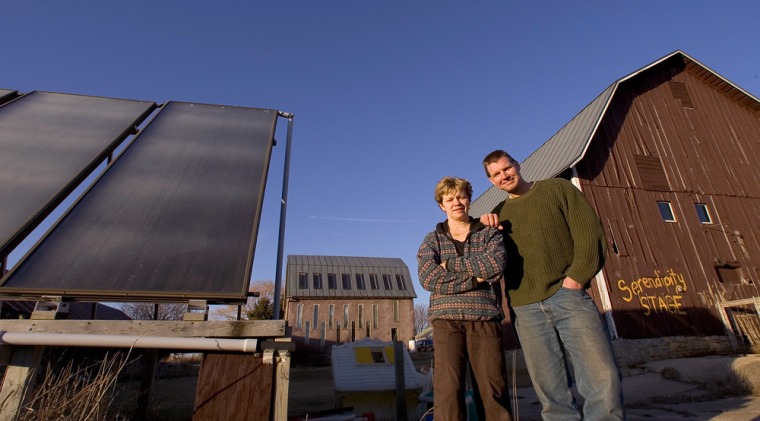Recycling soda cans, using phosphate-free cleansers and making smart transportation choices can all improve the environment. But did you know that applying for a home loan also offers a chance to further the environmental cause?
“What many people don’t realize is that homes account for about 21 percent of our greenhouse emissions,” says Steve Baden, executive director of Residential Energy Services Network, which maintains certification standards for home energy ratings.
This is why improving home energy efficiency matters. And given the rising cost of heating and cooling homes, it can also matter to household finances.
Brian Berg, vice president for corporate communications at ShoreBank in Chicago, says consumers can save up to 45 percent off their monthly utility bills with an investment of just a few thousand dollars.
"This is why when someone comes to us for a mortgage or home improvement loan, we talk to them about how adding a ‘green’ element to their request might make more financial sense over the long run," says Joel Freehling, ShoreBank’s manager of "triple bottom line innovation."
(The "triple bottom line" refers to benefits for the bank, the community and the environment.)
These green conversations include talking about what it would take to make the borrower's home more energy efficient — from spending a few additional dollars and hours caulking to choosing qualified appliances and building materials. The idea is to help identify where the borrower can get the biggest bang for their borrowed bucks.
While the bank may wind up booking a larger loan than originally requested to cover the added energy improvements, it does so only to the extent that projected lower utility costs will offset the higher loan costs.
This should leave the customer in a better financial position to repay the loan. The home itself not only becomes more comfortable to live in but easier to sell — and potentially more valuable — due to its energy efficiency. Along the way, the community-at-large, not to mention the environment, benefit from lowered carbon emissions.
This is what makes the lending "green."
Anyone can lend green
Green mortgages — known as Energy Efficient Mortgages or Energy Improvement Mortgages — are not new. They trace their lineage back to the days of the Carter administration.
Nor are they unique to banks like ShoreBank, which holds its mortgages in its own portfolio, giving it greater flexibility in tailoring loans to each borrower’s circumstance. Theoretically, any conventional lender has the ability to go green.
That is because all the usual suspects — Fannie Mae, Freddie Mac, FHA and HUD — provide lenders with underwriting standards for structuring green loans to conform for resale into the secondary market.
The key difference between a "green" loan vs. a conventional one from a borrower’s perspective is that it requires an extra step — an energy audit. This can cost a few hundred dollars and may delay processing by a few days. But the audit’s cost can be rolled into the loan. Also, rebates and incentives are often available to offset the cost of the audit.
"There has been nothing special about the process over that of doing a conventional financing," says Lan Richart, who along with his wife, Pam, recently used ‘green’ financing to purchase and fund renovation of a multi-unit building in Chicago. "Actually, the energy audit would have been worth it even if the bank had not paid for it." The audit pinpointed ways they could further boost the building’s energy efficiency.
The other key difference with ‘green’ mortgages is that they help borrowers qualify for larger loans. That is because the estimated utility cost savings are added back to income, creating additional borrowing power.
On the surface, encouraging people to borrow more than they initially intended to may not seem like a great idea in the aftermath of the housing bubble. But the utility savings should offset any extra loan costs, and the additional amount typically amounts to a few thousand dollars, not a significant stretch.
"Because our monthly energy cost will be significantly less than for a comparable home built with conventional building materials, the future expense of living in the home will be less," explains Charles Heppner, who along with his brother Timothy is building a green home in Chicago with green financing.
In a way it is like buying an energy-efficient hybrid car. You may pay more up front, but given enough time, the savings realized at the pump should justify the higher initial cost, not to mention the satisfaction that comes from reducing your carbon footprint.
Incentives and rebates
Also, green homes are magnets for rebates, tax breaks and cash incentives as many states, municipalities, manufacturers, utilities and even banks chip in to make financing a greener home more attractive and affordable.
To encourage its customers to build Energy Star compliant homes, Bank of America offers up to $1,000 off its closing costs, according to Michael Kelly, first mortgage product manager with Bank of America in Minneapolis. Green lending remains a niche area for the bank but one that is receiving more emphasis.
Jeffrey Cole, founder of Atlanta-based myEnergyLoan.com runs a national program through HomeFirst Mortgage to create packages of incentives, rebates and financing for his developer and residential customers’ green projects. "Generally, the greater the energy efficiency expected, the greater the potential savings available to the borrower," says Cole.
These incentives and rebates vary significantly from town to town, and over time. The Energy Star Web site maintains links to its partner’s current programs. Similarly, the Database of State Incentives for Renewables and Efficiency provides a state-by-state rundown of available programs and their details.
